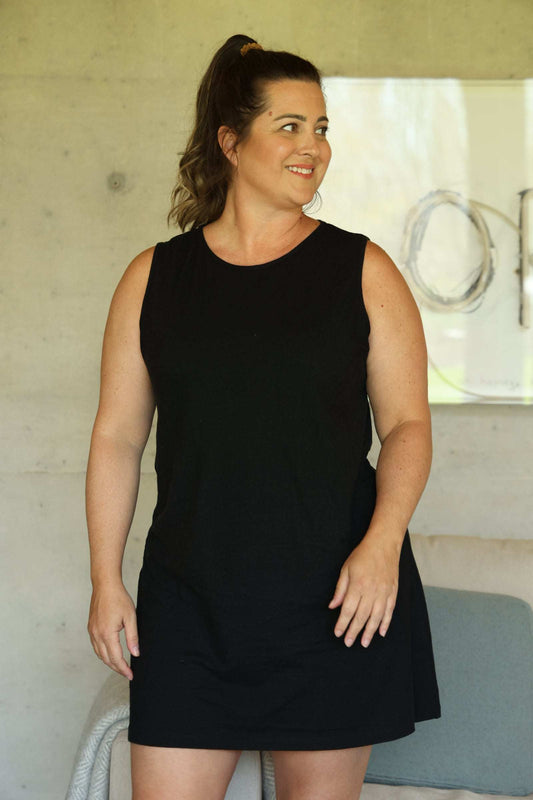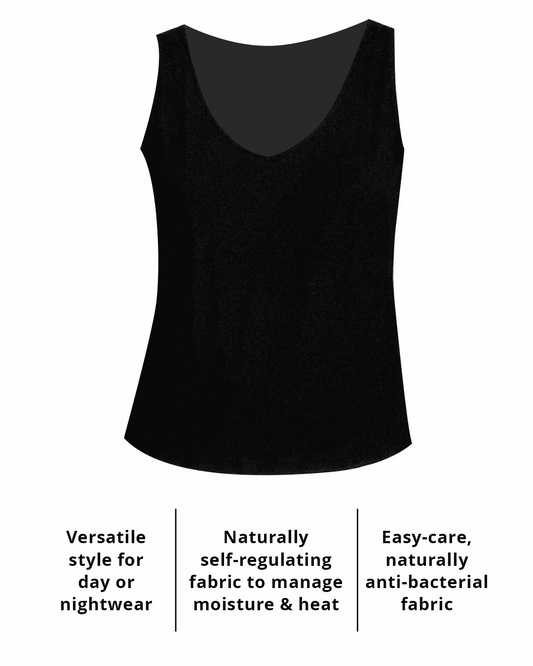Perimenopause Night Sweats and the Right Sleepwear
Perimenopause Night Sweats and The Challenge of a Good Night's Sleep
Perimenopause brings a lot of mental and physical changes for the average 40+ year old woman. Chief among these are night sweats. These middle-of-the-night episdoes can really mess with our precious sleep time. I’ve been there, so I understand your pain. You're busy running the world by day, and you deserve to sleep like a baby (or is it a dog – don’t they sleep better than babies?). Not to worry, we're uncovering how the right strategies and sleepwear could help you be the hero of this bedtime story, helping you control those night sweats and reclaim your sleep. Let's unlock the secret to a more peaceful slumber, shall we?
The Perimenopause and Night Sweats Connection
Perimenopause is the stage in our life that marks the beginning of the transition into menopause. It's the "before" phase, if you will, when our bodies and minds go through some fairly significant changes.
Perimenopause usually starts in your early 40s and can last anywhere from 2 to 10 years before your one official day of menopause. During that time, your ovaries start decreasing the level of hormones they produce, especially estrogen – which is one of the reasons you start to experience symptoms.
Estrogen has a number of important roles in the body. But estrogen doesn’t decline evenly, no, that would be too easy. Instead, in most women, it behaves in an erratic way, producing too much and then not enough. Meanwhile, progesterone declines as well, but at a different pace. It is this imbalanced reduction between the two hormones that scientists believe causes the symptoms you might be experiencing.
One of those symptoms is hot flashes at night – also known as night sweats. Night sweats are insidious. They can come and go as they please, or just continue to hang around, night after night. If they go on for an extended period of time, they will wreak havoc on you – causing serious sleep deprivation which has all kinds of other health issues associated with it. To make matters worse, you’re also probably sleeping in soggy sleepwear, sheets and covers. So not only are you barely sleeping, you’re also completely uncomfortable, all night long, night after night.
Yuck.
When will it end?
You might be wondering how long these perimenopause night sweats last. That’s the mystery. The good news, they are generally short-lived in most people and you can get your sleep back quickly.
In other cases, they can last for years. Yes, years. In fact, some women I’ve talked to are still getting night sweats in their 70s. As one woman said to me, “I guess I’m a lifer” (sad face emoji).
Are there things that make night sweats worse?
We’ve written a few articles about what can trigger night sweats, regardless of the stage of menopause you’re in. In a nutshell, you might find that certain foods, beverages and lifestyles can trigger your night sweats and make them worse than they already are. In my case, for instance, red wine had me flipping the covers all night long while herbal tea before bed made my early night sweats worse. The solutions were to avoid red wine and drink my tea earlier in the evening. We have a night sweats tracking journal that can help you identify and adjust what triggers are making your night sweats worse. It will also help you with factors you might not have considered, such as room environment and fabric decisions for your sleepwear and bedding.
Solutions for perimenopause night sweats
There are many treatments available for night sweats in perimenopause. You can talk to your doctor about the different alternatives available. Also, visit menopause.org to find a menopause practitioner near you. Many of them now will also do virtual appointments. Treatments range from non-drug treatments such as:
- herbal supplements
- hypnosis
- cognitive behavioural therapy, and
- acupuncture
Healthcare professionals may prescribe:
- Hormone replacement therapy
- Sleep medication
- Low doses of anti-psychotic medication
- Other forms of medication
If you are truly suffering, make an appointment to see your health care practitioner and talk about the best options for you. Night sweats feel harmless at first, but they can take a toll on your physical and mental health. I liken them to the drip water torture. It’s okay at first, but after awhile they will drive you crazy.
Sleep comfort and night sweats
But here’s the crux of the matter – you need to get your sleep back now and what you’re wearing is completely soaked when you wake up – whether in the middle of the night or in the morning. One of the most important considerations is the type of fabric you’re sleeping in. Below I’ve outlined what works and what doesn’t to help you sleep more comfortably with night sweats.
Sleepwear options for perimenopause night sweats (to sleep comfortably with night sweats)
When I first started looking into changing out my sleepwear, I figured I’d switch to a breathable cotton nightgown and that would be the end of my woes. As I quickly discovered, that was definitely not the case. The science of heat, sweat and fabric is more complex than I first thought. The interaction of your body’s erratic furnace and your sleep environment involves biology, chemistry and physics. But don’t worry, I’ll skip to the end-result.
Your sleepwear
When you are a night sweats sufferer your body isn’t just hot, it’s hot AND cold. You need sleepwear and bed linens that can react and adapt to your body’s rollercoaster temperature changes.
Fabrics need to be able to draw heat and moisture away from your body towards the outside air where moisture can quickly evaporate and heat can dissipate. Generally, this type of reactive fabric is called thermoregulating fabric.
There are a few fabrics that behave this way naturally – it’s literally part of their DNA, and there are others that are synthetically made to behave this way either through the yarn creation, how it’s woven, or when a treatment is applied.
Here are the best natural and semi-synthetic thermoregulating fabrics:
- Hemp and hemp blends (like our Simone nightgown, naturally)*
- Linen and linen blends*
- Tencel/Lyocell and blends (bamboo and hemp Lyocell will be the most effective in this category. Note that bamboo viscose is NOT the same as bamboo Tencel – they behave very differently!)
*In all hemp and linen blends, the dominant fibre should be hemp or linen.
Do you notice the absence of cotton? Rayon/Viscose? Polyester? Even bamboo?
Cotton and Night Sweats
We love cotton as a supporting fibre – it’s lovely and soft and blends beautifully with hemp – but cotton LOVES water and dries very slowly. Further, it’s not great at managing heat – it has very little heat retention (so a fine cotton nightgown is lovely if you are a constantly hot but NOT sweaty sleeper).
Rayon and Night Sweats
Rayon is a semi-synthetic fibre mostly made from trees, sometimes bamboo and eucalyptus. Rayon sleepwear is highly breathable, but like cotton, it traps water in its fibres. It’s also not good at moderating heat, so there is little heat retention. If your night sweats are light and/or occasional, rayon might work well for you. If your night sweats are medium to intense, you will see no difference when wearing rayon sleepwear.
Bamboo and Night Sweats
According to the US Federal Trade Commission, there is no difference in the performance between bamboo viscose and any other rayon fabric – so, if you’re buying bamboo viscose sleepwear you should know that it will not perform any differently than plain old rayon or viscose made from beech trees (the most common feedstock for rayon). Note that all bamboo viscose/rayon fabric is required to be labeled as such in the US and Canada - however, some products sneak through as "bamboo" on their labels. If it feels soft and silky and the fabric tag says "bamboo" it is likely bamboo viscose.
Polyester and night sweats
We don’t like polyester, for a whole bunch of reasons – but when it comes to night sweats, most standard polyester sleepwear is going to act like plastic wrap and trap all that heat and moisture next to you keeping you soggy and uncomfortable all night long.
The exception is polyester that has been made to thermoregulate heat and moisture. There are specialty polyester fabrics (including microfibre and polymicrofibre) that are made specifically to manage sweat and moisture. Those might work really well for you.
Note that athletic wear – made for pulling heat and moisture away from your body is an option for hot sleepers but not a night sweats sufferer – with the heat and chill action.
Other fabrics we don’t like for night sweats
Wool and silk
You may be surprised that we don’t love these two beautiful and natural fabrics for night sweats. Both wool and silk are highly effective insulators. They trap heat in their fibres – and in wool’s case, between the fibres, keeping you warm and cozy. Yikes. I don’t know about you, but just thinking about being warm and cozy is making me break out into a sweat.
The exception is Merino wool
Merino wool is a thermoregulating fabric, similar to hemp and linen. If you love Merino wool and it works for you during the day, select summer weight Merino wool for your sleepwear along with lighter weight bedding than you would normally choose. As already mentioned, wool is a powerful insulator, so less is more.
Silk is a terrible moisture-manager. In fact, unless it’s washable silk, silk will slowly degrade over time. Silk, like wool, is an insulator. It traps heat in its fibres and is reluctant to let go. If you love silk, select the finest fibre and lightest silk you can find.
These fibres also tend to be a little more high maintenance than the fibres we love. Generally, they need hand washing or drycleaning, which is not ideal for garments you wear every night.
How and where to find out what your is your sleepwear fabric
Except for specialty sleepwear, most sleepwear isn’t going to highlight what fabric it's made of on their hangtags. It’s not important to the non-night sweats crowd. But to night sweats sufferers, knowing what you are sleeping in is half the battle.
All apparel is required to disclose what type of fabric it’s made from – including the blend amounts in the case of mixed fabrics. These labels can be found either at the back of the collar, or on the lower side of the garment, sewn into a seam. Take a look at your current sleepwear and see what the tags say. If you’re miserable in your sleepwear, avoid whatever you’re currently sleeping in and try new fabrics.

Another thing to remember
In addition to the type of fabric, it’s important to choose breathable, light to medium-weight fabrics.
Avoid flannels and fleeces, synthetic fabrics (polyester and nylon) that trap heat.
Also avoid heavy or dense fabrics as these will also trap the heat. Even our preferred choices (hemp, linen and Tencel) will be uncomfortable if they are too thick because of their insulating properties.
But there’s more…
I wish sleeping better was as easy as selecting the right sleepwear and falling into a blissful slumber once again. While that actually DOES work for some lucky people, it’s not the norm. Why? There are many reasons, including your relationship with insomnia (aside from night sweats), food and beverage and lifestyle habits.
In addition to those issues, which take time to solve, another issue is the rest of your sleep environment. You might have the best night sweats sleepwear in the world, but if your sheets, bed linens and mattress are preventing the heat and sweat from escaping it will stay next to you just as if you are wearing polyester.
So what can you do?
You can use your newly acquired knowledge to look at the fabric labels of your bed linens. (We'll be publishing a follow-up page on bed linens and mattresses shortly, so stay tuned!)
In the meantime, we've got some useful articles from our blog below that can help you get a handle on what to sleep in and what to avoid. If you have any questions, feel free to get in touch through our contact page, or subscribe to our newsletter to stay up-to-date with more fabric information and helpful tips to stay dry.
Subscribe to our newsletter to stay up-to-date on how to stay comfortable even with night sweats.
Our most popular articles for tips on sleeping better with night sweats
-

Sleep better tonight!
Read moreSleep becomes elusive when you suffer from night sweats. Here are a few tips that might get you back on track quickly.
-

Night Sweats in Peri/Menopause
Read moreWhy you may be getting night sweats and how to deal with them.
-

10 reasons you're waking up soaked
Read moreOne of our most popular articles. Night sweats are triggered by certain food, beverage and lifestyles. This article explains what might be causing yours and what to do about it.
-

5 tips for sleeping better with night sweats
Read moreNight sweats are one of the most common symptoms with peri/menopause. Take heart, however, there are certain actions you can take to help lessen their severity and frequency.
-

What not to wear to bed when you suffer from night sweats
Read moreWhen it comes to night sweats, what you wear or sleep in matters a lot more than you think. The right fabrics will help you sleep better.
-

The Timing of Exercise and Night Sweats
Read moreExercise is good for you, right? Yes - but WHEN and how intense it is also matters. Done right, it will help lessen night sweats.
-

7 things about night sweats I got wrong
Read moreBefore I experienced night sweats, I thought I had it all figured out. Turns out, I wasn't even close.
-

Chronic Night Sweats and Insomnia
Read moreInsomnia is bad enough on its own, but throw in chronic night sweats and your misery is intensified.
Start living more comfortably. Shop now.
Our moisture-wicking, heat-managing apparel can help you sleep better
-
Simone Cooling Nightgown — The Magic Dress for Hot Nights & Cool Days
Regular price $129.99 CADRegular price -
Vanessa Cooling Pajama Set - Tank Top and Shorts for Hot Sleepers
Regular price $147.98 CADRegular price -
Women's Cooling Tank Top for Night Sweats - The Vanessa Tank Top
Regular price $79.99 CADRegular price -
Women's Moisture-wicking shorts for night sweats and hot flashes
Regular price $82.99 CADRegular price












